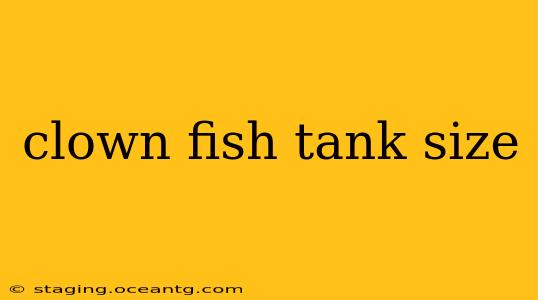Clownfish, with their vibrant colors and captivating personalities, are a popular choice for both beginner and experienced aquarists. However, providing these captivating creatures with a suitable environment is crucial for their well-being. This comprehensive guide delves into the ideal clownfish tank size, essential considerations for tank setup, and frequently asked questions to ensure your clownfish thrive.
What Size Tank Do Clownfish Need?
The minimum tank size for a single ocellaris clownfish (also known as percula clownfish) is 10 gallons. However, this is truly the bare minimum, and anything larger is significantly better. For a pair of ocellaris clownfish, a 20-gallon long tank is recommended. Larger species of clownfish, such as the maroon clownfish, require substantially larger tanks – at least a 30-gallon tank.
Remember, "bigger is better" when it comes to clownfish tanks. A larger tank provides more space for swimming, reduces stress, and allows for a more stable and healthy aquatic environment. The more space you give your clownfish, the happier and healthier they will be.
How Many Clownfish Can I Keep in a 20-Gallon Tank?
A 20-gallon long tank is suitable for one pair of ocellaris clownfish. Adding more clownfish to this size tank will overcrowd the environment, leading to increased stress, aggression, and potentially disease. Always consider the adult size of the fish and their space requirements when determining how many fish you can safely keep in a tank.
What About a 10-Gallon Tank for Clownfish?
While technically possible to keep a single ocellaris clownfish in a 10-gallon tank, it's strongly discouraged. This size restricts their movement and makes maintaining water quality more challenging, increasing the risk of stress and disease. A 10-gallon tank is better suited for smaller, less active fish. If you're committed to keeping clownfish, prioritize a larger tank for their long-term health and happiness.
What are the Ideal Tank Mates for Clownfish?
Clownfish are generally peaceful and can coexist with a variety of peaceful tank mates. However, it's essential to choose compatible species and avoid aggressive fish. Consider adding some of the following:
- Certain Gobies: Certain goby species are peaceful and compatible with clownfish.
- Small Damsels: Some smaller, less aggressive damsel species can coexist, but always research thoroughly before adding any damsels.
- Shrimp: Peaceful shrimp species can add to the biodiversity of the tank.
- Snails: Snails help keep the tank clean.
It's crucial to research the specific needs and temperament of any potential tank mates to ensure a harmonious and healthy environment. Avoid any fish that are known to be aggressive or territorial.
How to Set Up a Clownfish Tank: Essential Considerations
Beyond tank size, several factors are critical for a healthy clownfish habitat:
- Filtration: A robust filtration system is paramount for maintaining water quality. Consider canister filters or high-quality hang-on-back filters.
- Substrate: A fine sand substrate is ideal for clownfish.
- Live Rock: Live rock provides essential beneficial bacteria and hiding places for clownfish.
- Water Parameters: Maintaining stable water parameters (temperature, salinity, pH) is essential.
- Lighting: Clownfish require moderate to bright lighting.
- Regular Water Changes: Regular water changes help maintain water quality and prevent the buildup of harmful substances.
By addressing these factors, you'll create a thriving environment that promotes the well-being of your clownfish.
Conclusion
Selecting the appropriate tank size is paramount for keeping happy and healthy clownfish. While smaller tanks might seem tempting, prioritizing a larger tank ensures your clownfish have the space to thrive, reducing stress and the risk of disease. Remember to thoroughly research all aspects of clownfish care before bringing them home, and enjoy the vibrant beauty they bring to your aquarium!
